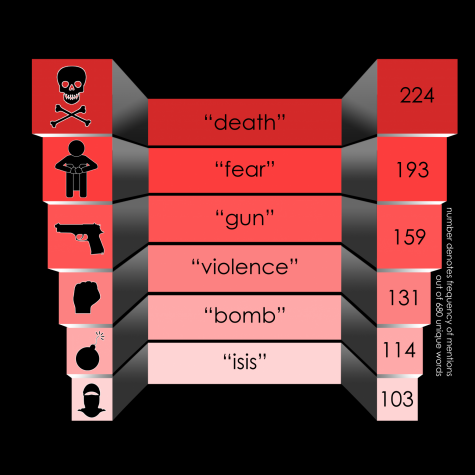Media’s stranglehold on perception
December 7, 2017
 According to a recent survey, “ISIS” was one of the top ten words Lynbrook students associated with acts of terror. The second most frequently Googled term in recent years, ISIS has received the exponential media coverage necessary to spread their message of fear and acquire new recruits over the past decade.
According to a recent survey, “ISIS” was one of the top ten words Lynbrook students associated with acts of terror. The second most frequently Googled term in recent years, ISIS has received the exponential media coverage necessary to spread their message of fear and acquire new recruits over the past decade.
While most members of ISIS are Muslim, relatively few members of Muslims in the US have any ties to the terrorist organization. President Trump’s team has incorrectly labeled many terrorist attacks, specifically ones with Muslim perpetrators, as underreported; Muslim perpetrators represent 44 percent of media coverage on terrorist attacks, but only 12 percent of actual terrorist attacks. A study conducted in 2017 by the Pew Research Center also found that 35 percent of U.S. adults believe there to be significant amounts of extremism among U.S. Muslims, and 41 percent believe that Islam encourages violence over any other faith.
Reporting has ingrained a misleading association between Muslims or Islamic groups such as ISIS and fear or terror within the U.S. population. The repeated coverage of terror and associated organizations has also created an aura of media sensationalism, encouraging violence among potential perpetrators. Because the public’s main source of information following an attack is the media, accurate reporting is essential to correctly inform the public. Unfortunately, misinformation spreads rapidly, and the effects of biased news can have lasting effects on the public.
The world has not yet settled on a standard definition of “terrorism,” but the U.S. Code of Federal Regulations defines it as “the unlawful use of force and violence against persons or property to intimidate or coerce a government, the civilian population, or any segment thereof, in furtherance of political or social objectives.” In order to correctly qualify an attack as an act of terror, it is necessary to investigate whether or not there is a political or ideological agenda behind the task.
Recent events have also led to the discussion of double standards in the portrayal of terrorist or other attacks. Oftentimes, an offender of color will be labeled as a terrorist, while a caucasian individual who commits similar acts is often humanized. As CBS political analyst Jamelle Bouie tweeted early this year in October, “Essentially, by the definition currently in common currency, a white person cannot be a terrorist.”
In the case of the murder of British Parliament member Jo Cox in June of 2016, perpetrator Thomas Mair, who was white, was deemed neither a “terrorist” nor a “possible terrorist” even though it was proven that he was politically motivated to commit the crime. On the other hand, Indian Muslim Nisar ud-Din Ahmed was jailed for 23 years after being falsely accused of plotting terrorist acts.
False perceptions of people of color have led to a sense of unease even locally. For example, freshman Anoushka Naik was inaccurately labeled as dangerous at a local Starbucks when she was 12 years old.
“A woman kept looking at me weirdly, and I later heard her telling her daughter to stay away from people like me, saying they’re bad, they’ll hurt you,” said Naik. “I felt disappointed because she was telling her young daughter that people like me, people of color, are going to hurt her. I wanted to speak out at that moment and say I wouldn’t hurt anyone. But in that moment, I felt like it would have just added to that girl’s fear of me and I didn’t want that.”
 ISIS has also established itself as the primary organization associated with terror through the media, strategically claims responsibility for attacks which affect a large group of people. As a result, an increased coverage of ISIS and its involvement allows ISIS and other organizations to spread their word to the public, encouraging more individuals to join their efforts. According to a study conducted by Economics and Finance professor Michael Jetter from EAFIT University in Colombia, there exists a clear association between the amount of coverage of a terrorist incident and the number of subsequent attacks over the next few weeks.
ISIS has also established itself as the primary organization associated with terror through the media, strategically claims responsibility for attacks which affect a large group of people. As a result, an increased coverage of ISIS and its involvement allows ISIS and other organizations to spread their word to the public, encouraging more individuals to join their efforts. According to a study conducted by Economics and Finance professor Michael Jetter from EAFIT University in Colombia, there exists a clear association between the amount of coverage of a terrorist incident and the number of subsequent attacks over the next few weeks.
“Whether it is the Taliban, al-Qaida, Boko Haram or, recently, ISIS, terrorism is everywhere on TV stations, newspapers and the radio,” Jetter said. “Terrorists need media coverage to spread their message, create fear and recruit followers. However, until now we did not know whether media attention actively encourages terrorist attacks.”
The media is a critical aspect in making the government accountable for its actions and keeping the public well-informed. News journalists have the ability to selectively filter out what the public hears; consequently, they are the public’s instrument to learn what is going on. The lack of accuracy on issues has been attributed to many things, most notably the lack of regulation on what can be published online and the ease which information can be distributed online.
“The book ‘Brave New World’ explains a situation in which everything is flipped,” said Economics and Government teacher David Pugh. “Facts become fiction, fiction becomes facts, which is kind of what’s happening today… We don’t know what to believe.”
Many Americans doubt the dependability of news sources, and in a poll done by Quinnipiac University in January, more than half of the sample group showed doubt in the system. Likewise, over 55 percent of Lynbrook students did not trust the media to report objectively. The most problematic aspect of the issue is the need to keep opinion and analysis separate.
“People need to look at media just to give themselves facts,” said senior Sultaan Ahmed. “There shouldn’t be a liberal or conservative media, they’re just supposed to give us information.”



